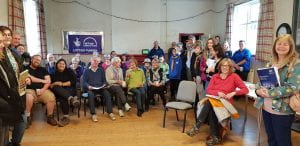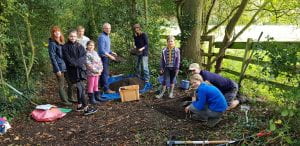Nine test pits were excavated in Old Dalby in October 2019 (Parker 2020) by around 50 local residents supported by the Old Dalby History Group (and the local pub! ). One test pit (number 9) was sited in Queensway and produced only modern material, the other eight were located in Old Dalby itself.
). One test pit (number 9) was sited in Queensway and produced only modern material, the other eight were located in Old Dalby itself.
 No material preceding the ninth century was recovered from any of the 2019 test pits, but test pits 1, 7 and 8 all produced sherds of Stamford ware (c. AD 850-1100). These pits were located some considerable distance apart (350m or more) in very different parts of the present settlement, suggesting a dispersed pattern of settlement at this time. The presence of Stamford ware in test pit 7, immediately north of the field containing the deserted settlement earthworks, was notable as it suggests that this part of the settlement certainly predates the preceptory and possibly the Norman period.
No material preceding the ninth century was recovered from any of the 2019 test pits, but test pits 1, 7 and 8 all produced sherds of Stamford ware (c. AD 850-1100). These pits were located some considerable distance apart (350m or more) in very different parts of the present settlement, suggesting a dispersed pattern of settlement at this time. The presence of Stamford ware in test pit 7, immediately north of the field containing the deserted settlement earthworks, was notable as it suggests that this part of the settlement certainly predates the preceptory and possibly the Norman period.
For the twelfth to fourteenth century, only test pits 7 and 8 produced sufficient pottery to indicate habitation in the vicinity: again, these are more more than 350m apart, hinting that Old Dalby was then either very large or dispersed.
The absence of pottery of this date from test pits 2-6 might support the latter explanation in the south-western part of the village, although with a relatively small number of pits excavated it is difficult to be confident of this, while twelfth to fourteenth century finds noted above from excavation along Main Street hint that settlement may have been larger or more continuous north-west of test pit 7. Notwithstanding these uncertainties, the test pits do usefully indicate that the main part of the present settlement was in existence in some form before the now-deserted area southeast of the village was abandoned.
 Three test pits (3, 4 and 7) produced pottery of fourteenth to sixteenth century date, giving little indication of post-fourteenth century contraction seen widely elsewhere, although they do hint at come settlement shift at this time.
Three test pits (3, 4 and 7) produced pottery of fourteenth to sixteenth century date, giving little indication of post-fourteenth century contraction seen widely elsewhere, although they do hint at come settlement shift at this time. 
Five pits produced pottery of sixteenth to eighteenth century date, three of which were around the green by Chapel Lane, suggesting that this became the main focus of settlement at this time.
Notably, test pit 7, near the deserted settlement earthworks, produced no pottery of this date, suggesting this part of the village was abandoned sometime around the fifteenth or sixteenth centuries. This may have coincided with the closure of the Hospitaller preceptory in AD 1540, whose earthwork remains lie immediately south of the settlement earthworks.

